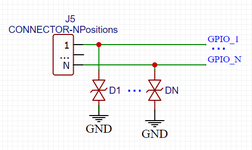michcfr
Advanced Member level 4

Hello,
I want to minimize the number of ESD diode protection to place on my circuit.
The circuit is a kind of bus of N GPIO lines shared by P connectors each with N pins (one per GPIO). See the figure 1. At the level of each connector, I would then place N ESD diodes (like in figure 2). So, the number of ESD diodes to place on my circuit is: PxN
But, I have P=8 connectors and N=36 GPIO lines, so I would need to place 288 ESD diodes!! this is huge, even with multiple channel ESD diodes ICs.
Now, I am looking for alternative solutions to minimize or fatorize the ESD diodes on my circuit. If somebody can help. Thank you
Regards,
Michel
I want to minimize the number of ESD diode protection to place on my circuit.
The circuit is a kind of bus of N GPIO lines shared by P connectors each with N pins (one per GPIO). See the figure 1. At the level of each connector, I would then place N ESD diodes (like in figure 2). So, the number of ESD diodes to place on my circuit is: PxN
But, I have P=8 connectors and N=36 GPIO lines, so I would need to place 288 ESD diodes!! this is huge, even with multiple channel ESD diodes ICs.
Now, I am looking for alternative solutions to minimize or fatorize the ESD diodes on my circuit. If somebody can help. Thank you
Regards,
Michel



